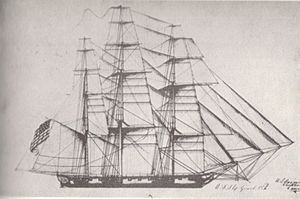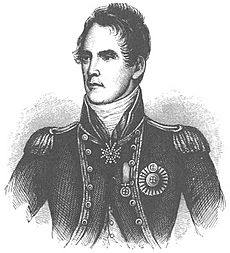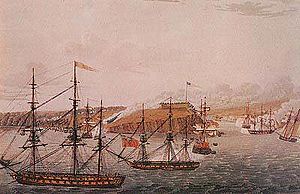Engagements on Lake Ontario facts for kids
Quick facts for kids Engagements on Lake Ontario |
|||||
|---|---|---|---|---|---|
| Part of the War of 1812 | |||||
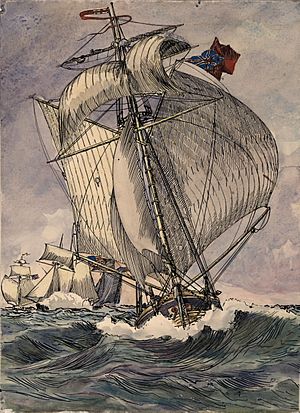 Governor Simcoe pursued by American ships off Kingston, Upper Canada |
|||||
|
|||||
| Belligerents | |||||
| Commanders and leaders | |||||
| James Lucas Yeo | Isaac Chauncey | ||||
| Strength | |||||
| 1 first rate ship of the line 2 frigates 6 sloops and brigs 4 schooners and gunboats |
2 frigates 6 sloops and brigs 12 schooners and gunboats |
||||
| Casualties and losses | |||||
| 1 sloop destroyed 2 brigs destroyed 1 brig captured |
1 brig destroyed 2 schooners sunk 2 schooners captured |
||||
The Engagements on Lake Ontario were a long naval contest for control of Lake Ontario during the War of 1812. Not many big battles happened, and none of them had a clear winner. This fight mostly became a race to build the most ships, which some people jokingly called the "Battle of the Carpenters."
Contents
When the war started, the British had an early lead on the Great Lakes. They had a group of ships called the Provincial Marine. Even though these ships were not always well-manned, they were the only ones on Lake Erie and Lake Huron at first. This helped the British win important early victories.
On Lake Ontario, the British had ships like Royal George and Prince Regent. They also had smaller ships called brigs and schooners. Their main base was at Kingston Royal Naval Dockyard. The American side only had one brig, Oneida, and a small navy yard at Sackets Harbor, New York. On July 19, British ships attacked Oneida in the First Battle of Sacket's Harbor, but the Americans fought them off.
To even things out, the United States Navy put Commodore Isaac Chauncey in charge of their ships on the lakes. Chauncey focused on Lake Ontario. He bought or took over some trading ships. He also sent many carpenters and shipbuilders to Sacket's Harbor. Their goal was to build proper warships. They launched their first new ship, Madison, on November 26. The trees for this ship were still standing in the forest just two months before!
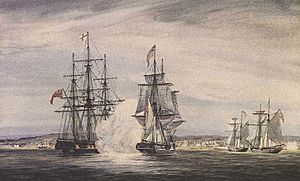
On November 6, Chauncey led his ships to chase the British ship Royal George into Kingston. He was pushed back by shore defenses and gunboats. One of his ships, Pert, had a gun explode, which caused confusion. After this, winter arrived, trapping ships in port. Chauncey worried the British might attack across the ice. He kept his carpenters busy cutting ice around his ships so they could fire at any attackers. However, the British did not plan such an attack.
The British started building two new ships to match Madison. One was built at Kingston and the other at York. Their work was slow, especially at York, because of disagreements among the builders. The Admiralty (the British navy leaders) then sent Captain James Lucas Yeo to take command of the British ships on the Great Lakes. He brought more sailors and supplies from Britain in early 1813.
Battles and Building in 1813
When the ice melted, Chauncey had more ships and sailors. He and General Henry Dearborn, the American army commander, had a chance to attack before more British sailors arrived. An attack on Kingston would have been a big win. But Chauncey and Dearborn thought Kingston had 5,000 British soldiers, when it only had 600. So, they attacked York instead, which was the capital of Upper Canada.
On April 27, at the Battle of York, the Americans defeated the British defenders. They looted the town and captured a British ship called Duke of Gloucester. They also took cannons meant for British ships on Lake Erie. This helped the Americans win later at the Battle of Lake Erie. The British themselves burned their unfinished ship, HMS Sir Isaac Brock, to stop it from being captured.

Chauncey and Dearborn then defeated the British army at the Battle of Fort George on May 27. At both York and Fort George, Chauncey's smaller ships were very helpful. They supported the American troops landing from boats. They fired at British defenses and caused many casualties.
The American commanders had left themselves open to a counter-attack. While they were busy at the western end of Lake Ontario, Commodore Yeo arrived in Kingston. He brought 465 Royal Navy officers and sailors. With troops, he quickly attacked the American base in the Second Battle of Sacket's Harbor on May 29. Even though this was a bold move, Yeo and the British general attacked carefully. They stopped the attack when they met strong resistance. The Americans had set fire to the captured Duke of Gloucester and a large ship being built, General Pike. But they managed to put out the fire on General Pike when the British left.
Chauncey quickly returned to Sacket's Harbor. He stayed there until General Pike was finished. While the Americans stayed in port, Yeo's ships helped push the American army back into Fort George. His ships captured American supply boats and raided their camps. On July 1, Yeo tried to destroy General Pike by raiding Sacket's Harbor with small boats. But he called off the attack because he knew the Americans had been warned.
Chauncey's full group of ships finally sailed out on July 21. They first took 250 soldiers to attack British defenses at Burlington Heights. But they found the water was too shallow for Chauncey's ships to help. The British defenders were also too strong for an attack without ship support. Instead, they briefly captured York again, but caused little damage this time.
The Fight off Niagara
On August 7, the American and British ships met near the Niagara River. For several days, both groups moved carefully. Chauncey had better long-range guns and waited for calm weather. Yeo had better short-range guns and wanted to fight in stormy weather. On the night of August 8, two American ships, Hamilton and Scourge, sank in a sudden storm.
On August 10, the British had the advantage of the wind. Chauncey arranged his ships in two lines. The smaller ships were closer to the British. As the British got closer, the fighting began. Chauncey ordered his front line to move away. But two ships, Growler and Julia, failed to turn properly. They were cut off from the rest of Chauncey's ships. Chauncey pulled back, hoping Yeo would follow. Instead, Yeo focused on the two isolated ships and captured them both.
The Fight off Genesee
Both groups of ships went back to their bases for supplies. On September 11, there was another fight off the Genesee River. The British ships were stuck in calm water. For hours, American ships fired at them from far away. The British tried to move their ships by towing them with boats. As evening came, a breeze allowed Yeo to pull away and retreat.
The Fight off Burlington
On September 28, the two groups met again in York Bay. Chauncey was helping to move the American army. Yeo had just delivered supplies to British forces. Both sides saw each other early in the morning. They sailed south in strong winds.

Around 12:40 pm, Yeo suddenly turned around. He wanted to fire one big shot at General Pike as they passed. Then he planned to attack the weaker American ships. However, Chauncey also turned. General Pike and Yeo's main ship, Wolfe, fired at each other several times. The American fire damaged Wolfe's masts. Yeo's second-in-command moved his ship, Royal George, to protect Wolfe. Wolfe then sailed away towards Burlington Bay.
For a while, the ships were mixed up. Chauncey's captain wanted to capture two British ships. But Chauncey said, "All or none," and chased after Wolfe. He still refused to let go of the rope towing one of his slower ships. No other American ships could get close enough to help.
After a chase of 90 minutes, Yeo dropped anchor. The wind had become a gale, and the American ships were spread out. General Pike was also damaged. Chauncey stopped the attack. He said that if he continued, both sides might crash ashore in British territory.
Later Actions in 1813
While Yeo repaired his ships, Chauncey controlled the lake. Yeo escaped from Burlington on October 2. The next day, Chauncey chased him. On October 5, Chauncey saw seven British ships. They were gunboats and unarmed ships carrying troops. He captured five of them, including Growler and Julia, taking 264 prisoners.
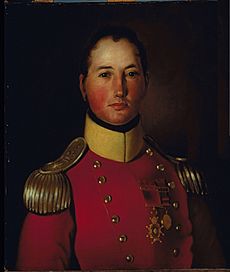
The fighting then moved to the Saint Lawrence River. American control of the lake allowed them to move their troops for a planned attack on Montreal. As the American army moved, some British ships fired at their camps. On November 5, American artillery drove them off.
The American army then started moving down the St. Lawrence River. Chauncey was supposed to block the British ships in Kingston. But bad weather and many small islands made this hard. This allowed British ships to return to Kingston. They picked up troops and chased the Americans down the river. On November 11, these British forces, helped by three gunboats, defeated the Americans at the Battle of Crysler's Farm.
The last event of the year was moving American troops from Niagara to Sacket's Harbor. This left the Niagara area without many soldiers. The British took advantage of this, capturing Fort Niagara and fighting the Battle of Buffalo.
During the winter of 1813-1814, the Americans sent some shipbuilders and materials to Lake Champlain. This helped them build ships that later won the Battle of Plattsburgh. In Kingston, the British greatly improved their shipyards.
Since Chauncey's ships had been stronger in 1813, Yeo ordered two big new ships called frigates. When these were ready, Yeo had the advantage. On May 6, he attacked Fort Oswego to stop American supplies from reaching Sacket's Harbor. The attack was partly successful. The British captured several unarmed ships, including Growler, which was captured for the third time!
Yeo wanted to capture heavy guns meant for Chauncey's new ships. Most of these guns had not reached Oswego yet. Yeo then tried to block the river to stop the guns from reaching Sacket's Harbor. A few weeks later, American boats loaded with cannons tried to reach Sacket's Harbor. British marines and sailors tried to capture these boats. But on May 30, they were ambushed and all were killed or captured at the Battle of Big Sandy Creek.
Soon after, Chauncey received his guns. He finished two frigates, Superior and Mohawk, which were even bigger than Yeo's. He also finished two heavily armed brigs. However, Chauncey's ships were not ready until mid-July. He was sick and refused to let his second-in-command take charge. This slowed down the American army's plans. When the American ships finally sailed, Yeo quickly went back to Kingston. This set the pattern for the year: whoever had fewer ships or guns stayed in port until they built something bigger.
Later Battles in 1814
While the Americans controlled the lake, they destroyed a British ship being built on the Saint Lawrence River.
On August 5, three British ships sailed with supplies. One ship, Magnet, was caught by Chauncey's ships. It was run ashore and burned to prevent capture. Its commander was later dismissed from the Royal Navy.
Chauncey focused on blocking Kingston. Yeo had no plans to leave while his ships were weaker. American army commanders criticized Chauncey for not helping the army more. This led to no clear winner in the Niagara campaign. Only three smaller American ships loosely blocked the Niagara River. The crews of three small British ships there carried boats overland. They captured two American ships from Lake Erie. These British sailors later tried to storm Fort Erie, but failed with many losses.
On September 21, Chauncey's ships moved American troops to reinforce the army on the Niagara. The new general refused to attack the British army and eventually retreated.
The Biggest Ship: HMS St Lawrence
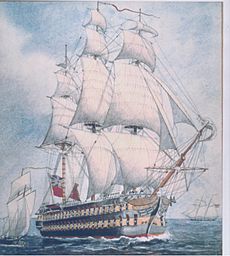
When Yeo learned Chauncey was building more ships, he ordered an even bigger ship to be built. This was the ship of the line St Lawrence. It was launched on October 15. On October 19, lightning struck Saint Lawrence, but it was not destroyed.
Chauncey then retreated into Sacket's Harbor. Yeo controlled the lake until November 21, when winter arrived. Like Chauncey, Yeo preferred to stay near the enemy port. He did not support the British army at the western end of the lake until the very end of the sailing season.
End of the War
The Americans started building two even larger ships than St Lawrence. But the British also continued building ships. However, the British commanders started having disagreements. The war ended with the Treaty of Ghent.
What Happened After the War?
After the war, Britain and the United States signed a special agreement in 1817. It was called the Rush–Bagot Treaty. This treaty limited the number and size of warships each country could have on the Great Lakes. On Lake Ontario, each country could only have one ship, no bigger than 100 tons, with one 18-pounder gun. They agreed not to build more armed ships and to take apart the ones they had.
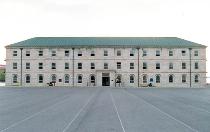
Most of the existing ships were not actually broken up. The British built a large storehouse, called a "stone frigate," to keep ship parts. This building is still used today by the Royal Military College of Canada. In theory, the British could have quickly put their ships back into service. But by 1827, all the ships were rotting and could not be used. The remaining ships were sold or sunk in the next few years.
The American ships also quickly fell apart. They were built quickly with "green wood" (wood that wasn't fully dried), so they were only expected to last a few years. One unfinished ship, New Orleans, was covered by a large shed. The shed collapsed in 1881, and the ship's remains were sold in 1883.
Why Was This Important?
Neither side was willing to risk everything in a big attack on the enemy fleet or base. So, all the effort to build ships on Lake Ontario ended in an expensive tie. The huge need for sailors and materials for these ships affected other parts of the war.
The American base at Sacket's Harbor was a small town. It could not handle all the soldiers, sailors, and shipbuilders. Many people died from cold, lack of food in winter, and disease in summer. On the British side, the effort to move all the cannons and naval supplies up the Saint Lawrence River stopped them from sending enough soldiers to Upper Canada. One British general complained that moving one huge cable for the ship Saint Lawrence cost a lot of money and used up all the transport services.
Historians have criticized both Yeo and Chauncey for not acting more decisively. They also complained about the long excuses they gave for their problems. Some American historians say Chauncey should have attacked Kingston or fought Yeo's ships more aggressively. Instead, Chauncey often avoided attacking Kingston. He also kept his ships in port waiting for more ships or refused to help the army's attacks elsewhere.
On the other hand, some argue that since the British strategy was mostly to defend, Yeo only needed to avoid defeat, which he did. However, other historians say he did this at such a high cost that other military operations were hurt. For example, Yeo's keeping of men and supplies for his own ships contributed to the British defeat on Lake Erie. Also, a much smaller effort on Lake Champlain could have guaranteed a British victory there.



